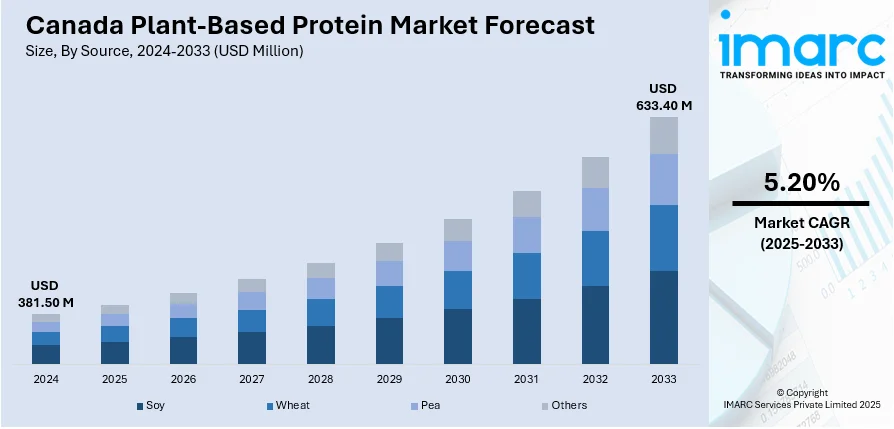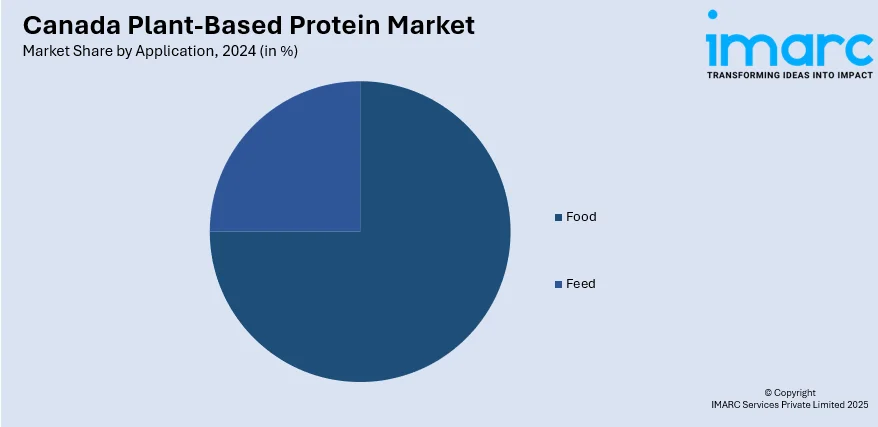
Canada Plant-Based Protein Market Size, Share, Trends and Forecast by Source, Type, Nature, Application, and Region, 2025-2033
Canada Plant-Based Protein Market Overview:
The Canada plant-based protein market size reached USD 381.50 Million in 2024. Looking forward, IMARC Group expects the market to reach USD 633.40 Million by 2033, exhibiting a growth rate (CAGR) of 5.20% during 2025-2033. The growing concerns about heart disease, obesity, and lifestyle-related illnesses, rising worries about the limitations of animal agriculture, including excessive land use, water consumption, and greenhouse gas emissions, and increasing advancements in texture, flavor, and nutrition are some of the factors impelling the market growth.
|
Report Attribute
|
Key Statistics
|
|---|---|
|
Base Year
|
2024 |
|
Forecast Years
|
2025-2033
|
|
Historical Years
|
2019-2024
|
| Market Size in 2024 | USD 381.50 Million |
| Market Forecast in 2033 | USD 633.40 Million |
| Market Growth Rate 2025-2033 | 5.20% |
Canada Plant-Based Protein Market Trends:
Health and Wellness Trends
Individuals in Canada are looking for healthier food options due to the rising concerns about heart disease, obesity, and lifestyle-related illnesses. Plant-derived proteins, with reduced cholesterol, lower saturated fat content, and improved digestibility compared to those from animals, are gaining popularity among many people. This trend is most evident with millennials and Generation Z, as these generations are increasingly health-oriented and actively pursuing healthy eating lifestyles. These groups are more inclined to adopt plant-based diets and add these proteins to their foods to satisfy a day's nutritional requirements. In 2024, McGill University, along with the London School of Hygiene & Tropical Medicine, released a study in Nature Food reporting on the advantages of substituting partially animal proteins with plant food in the Canadian diet. The study revealed that these food changes could add nine months to people's life expectancy and lower an individual's carbon footprint by 25%. The study highlighted that replacing red and processed meats with plant proteins had the most significant positive effect on both health and environmental grounds.

Increasing Demand for Alternative Protein Sources
Rising concerns about the drawbacks of animal husbandry, such as high land use, water consumption, and greenhouse gas emissions—are driving individuals and businesses to explore alternative protein sources. Plant proteins, such as pea, soy, lentils, and chickpeas, provide a scalable alternative to respond to increasing protein demand without the environmental cost associated with conventional animal husbandry. Such proteins not only maximize the use of resources but are also healthier because they contribute to lower cholesterol, better digestion, and so forth. With increasingly more individuals pursuing plant-based eating for health, ethical, and environmental reasons, food manufacturers are being urged to expand their products and create newer plant-based versions of meat, dairy products, and protein foods. In 2024, Danone Canada introduced new Silk Greek-style plant-based yogurt with Canadian pea protein, which has 12 grams of protein in each serving. This is part of a larger effort to incorporate locally sourced ingredients and make healthier, plant-based foods available in Canada. It comes in Key Lime and Vanilla flavors at retailers nationwide.
Advancements in Plant-Based Protein Technology
Innovations in texture, flavor, and nutrition are making plant-based proteins products more appealing to a broader consumer base, including those who traditionally prefer animal-based proteins. Companies are utilizing advanced methods like extrusion, fermentation, and cell-culturing to imitate the texture, flavor, and nutritional characteristics of meat, dairy, and eggs. These innovations not only enhance the sensory but also the nutritional value by enriching plant products with increased amounts of protein, vitamins, and minerals. In addition to this, ongoing research in plant breeding and processing is enabling the integration of new crops, including fava beans and lentils, into plant foods. These innovations are overcoming the barriers that kept some consumers away from adopting fully plant-based diets. In 2024, Protein Industries Canada initiated a project worth $24.5 million in collaboration with Roquette, Prairie Fava, BioNeutra, and Plant Up. This project is focused on enhancing process efficiencies by creating new food ingredients from plants like peas and fava beans.
Canada Plant-Based Protein Market Segmentation:
IMARC Group provides an analysis of the key trends in each segment of the market, along with forecasts at the region level for 2025-2033. Our report has categorized the market based on source, type, nature, and application.
Source Insights:
- Soy
- Wheat
- Pea
- Others
The report has provided a detailed breakup and analysis of the market based on the source. This includes soy, wheat, pea, and others.
Type Insights:
- Concentrates
- Isolates
- Textured
A detailed breakup and analysis of the market based on the type have also been provided in the report. This includes concentrates, isolates, and textured.
Nature Insights:
- Conventional
- Organic
The report has provided a detailed breakup and analysis of the market based on the nature. This includes conventional, and organic.
Application Insights:

- Food
- Meat Alternatives
- Dairy Alternatives
- Bakery Products
- Performance Nutrition
- Convenience Foods
- Others
- Feed
A detailed breakup and analysis of the market based on the application have also been provided in the report. This includes food (meat alternatives, dairy alternatives, bakery products, performance nutrition, convenience foods, others), and feed.
Regional Insights:
- Ontario
- Quebec
- Alberta
- British Columbia
- Others
The report has also provided a comprehensive analysis of all the major regional markets, which include Ontario, Quebec, Alberta, British Columbia, and others.
Competitive Landscape:
The market research report has also provided a comprehensive analysis of the competitive landscape. Competitive analysis such as market structure, key player positioning, top winning strategies, competitive dashboard, and company evaluation quadrant has been covered in the report. Also, detailed profiles of all major companies have been provided.
Canada Plant-Based Protein Market News:
- May 2024: Lactalis Canada launched its new plant-based brand, Enjoy!, featuring high-protein oat, almond, and hazelnut beverages. The line includes six unsweetened varieties, all made with 8 grams of pea protein per serving, and is produced at the company's newly converted plant-based manufacturing facility in Sudbury, Ontario.
- June 2024: Acenzia, a subsidiary of Novo Integrated Sciences, was selected to participate in a Protein Industries Canada project to develop plant-based protein products. The $5.4 million investment aims to create three consumer-ready protein products targeting both medical nutrition and active living markets.
Canada Plant-Based Protein Market Report Coverage:
| Report Features | Details |
|---|---|
| Base Year of the Analysis | 2024 |
| Historical Period | 2019-2024 |
| Forecast Period | 2025-2033 |
| Units | Million USD |
| Scope of the Report |
Exploration of Historical Trends and Market Outlook, Industry Catalysts and Challenges, Segment-Wise Historical and Future Market Assessment:
|
| Sources Covered | Soy, Wheat, Pea, Others |
| Types Covered | Concentrates, Isolates, Textured |
| Natures Covered | Conventional, Organic |
| Applications Covered |
|
| Regions Covered | Ontario, Quebec, Alberta, British Columbia, Others |
| Customization Scope | 10% Free Customization |
| Post-Sale Analyst Support | 10-12 Weeks |
| Delivery Format | PDF and Excel through Email (We can also provide the editable version of the report in PPT/Word format on special request) |
Key Questions Answered in This Report:
- How has the Canada plant-based protein market performed so far and how will it perform in the coming years?
- What is the breakup of the Canada plant-based protein market on the basis of source?
- What is the breakup of the Canada plant-based protein market on the basis of type?
- What is the breakup of the Canada plant-based protein market on the basis of nature?
- What is the breakup of the Canada plant-based protein market on the basis of application?
- What is the breakup of the Canada plant-based protein market on the basis of region?
- What are the various stages in the value chain of the Canada plant-based protein market?
- What are the key driving factors and challenges in the Canada plant-based protein?
- What is the structure of the Canada plant-based protein market and who are the key players?
- What is the degree of competition in the Canada plant-based protein market?
Key Benefits for Stakeholders:
- IMARC’s industry report offers a comprehensive quantitative analysis of various market segments, historical and current market trends, market forecasts, and dynamics of the Canada plant-based protein market from 2019-2033.
- The research report provides the latest information on the market drivers, challenges, and opportunities in the Canada plant-based protein market.
- Porter's five forces analysis assist stakeholders in assessing the impact of new entrants, competitive rivalry, supplier power, buyer power, and the threat of substitution. It helps stakeholders to analyze the level of competition within the Canada plant-based protein industry and its attractiveness.
- Competitive landscape allows stakeholders to understand their competitive environment and provides an insight into the current positions of key players in the market.
Need more help?
- Speak to our experienced analysts for insights on the current market scenarios.
- Include additional segments and countries to customize the report as per your requirement.
- Gain an unparalleled competitive advantage in your domain by understanding how to utilize the report and positively impacting your operations and revenue.
- For further assistance, please connect with our analysts.
 Inquire Before Buying
Inquire Before Buying
 Speak to an Analyst
Speak to an Analyst
 Request Brochure
Request Brochure
 Request Customization
Request Customization




.webp)




.webp)












